While the holidays certainly present a huge opportunity to drive up revenue, you should have loftier goals for your marketing strategy. Like capturing the attention of new shoppers, restoring interest in passive ones, and strengthening the loyalty of existing fans.
If you approach holiday marketing the right way, it can have a big impact on the long-term success of your company. Just keep in mind that there are billions of dollars up for grabs this time of year, so the competition is fierce.
Customers start hearing about Black Friday deals and holiday gift ideas as early as October — and the onslaught of messaging comes from everywhere. Email. Social media. TV. Radio and podcasts. Google. It almost seems impossible to cut through the noise.
The good news is, there’s a lot you can do to make your brand heard.
In the following guide, we’ll show you how to create a rock-solid holiday marketing strategy for your brand and provide you with 18 holiday marketing campaign ideas to get you started.
Maximize your holiday sales with our Christmas seasonal kit
What Are the Benefits of Holiday Marketing?
There are so many ways in which you can get in front of your audience over the holiday season. Unlock the right combination of messaging, timing, and placement, and your brand will reap the following benefits:
Attract Users
The holiday shopping season is a great time to attract customers new and old to your business.
There are many sales days you can take advantage of throughout November and December — starting with Black Friday and going straight through the new year. You can attract shoppers by advertising deals for:
- Black Friday
- Small Business Saturday
- Cyber Monday
- Cyber Week
- Super Saturday
You can also run winter and end-of-year sales events to capture sales in December after the major sales days have ended. The point is, don’t just pick one day to run a sale and expect it to be a major sales generator. You should be running campaigns all throughout the season, even if it’s for the purpose of growing your follower base or existing customer loyalty.
Paw.com, for instance, has been running holiday marketing campaigns on its website and across its social media throughout the season. Here’s what the company’s Instagram (@paworiginal) page currently looks like:
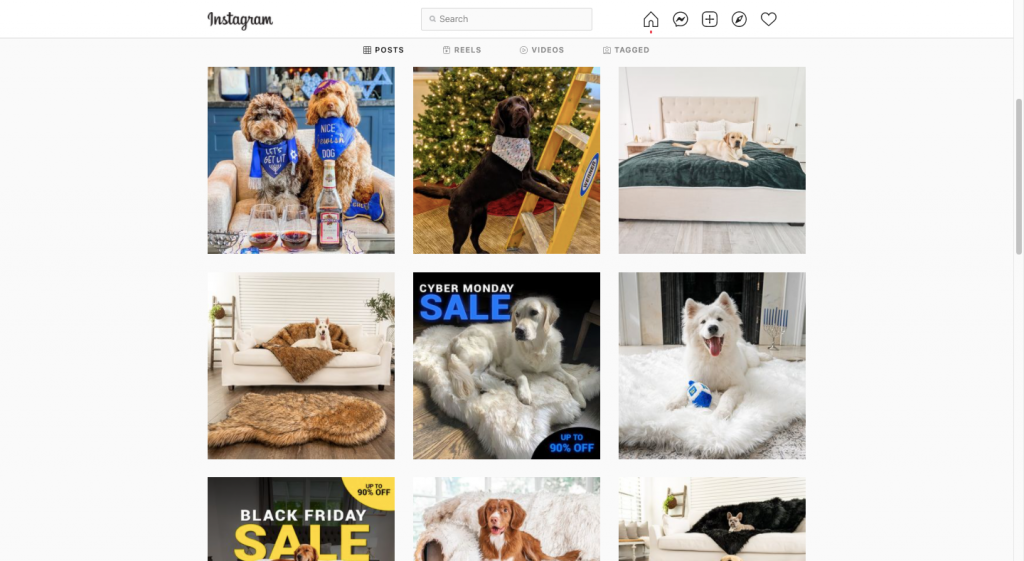
Their social media content includes festive product imagery interspersed with sales promotions. This is a good way to stay top-of-mind with current followers and customers and to drum up interest in those who are curious about the brand.
Increase Brand Exposure
When it comes to holiday shopping, it doesn’t really matter what you’re in the business of selling or how long you’ve been doing it. All that matters is that you have something that people are looking for this holiday season and you present them with the right offer.
This is why you need a holiday marketing strategy. By learning who your target audience is, what they need from you and how to best get it in front of them, you’ll more effectively cut through the noise and increase your brand exposure.
Let’s use another example from Paw.com to demonstrate this point. Here’s a paid promotion on Instagram that Paw.com is using to retarget new customers:
I never heard of Paw.com until I started seeing their ads this holiday season. But as a dog owner who shares and likes a lot of animal-friendly content on Instagram, it’s no surprise that I’d be retargeted with this ad.
Dog owners like myself are likely to stop and notice a video ad like this, even if we don’t know the brand. For starters, it’s a lot of fun to look at and has a cute dog in it. The content is perfectly tailored to us. Secondly, it offers an attractive introductory deal at 70% off their products.
This is a highly effective way to increase brand exposure and capture the attention of new customers.
Grow Your Revenue
According to eMarketer holiday shopping data, there are billions of dollars up for grabs this year. Brick-and-mortar sales are expected to reach $886 billion and ecommerce around $207 billion.
If you want to capture a chunk of that pie, don’t look for a one-size-fits-all approach to holiday marketing. There is no such thing.
It’s best to run a variety of holiday marketing campaigns — adapted for the sales day, timeframe as well as your target users. This will allow you to maximize your earnings throughout the holiday season.
Once more, let’s look at what Paw.com has been doing this holiday season. Here is what the Paw.com homepage looks like in early December:
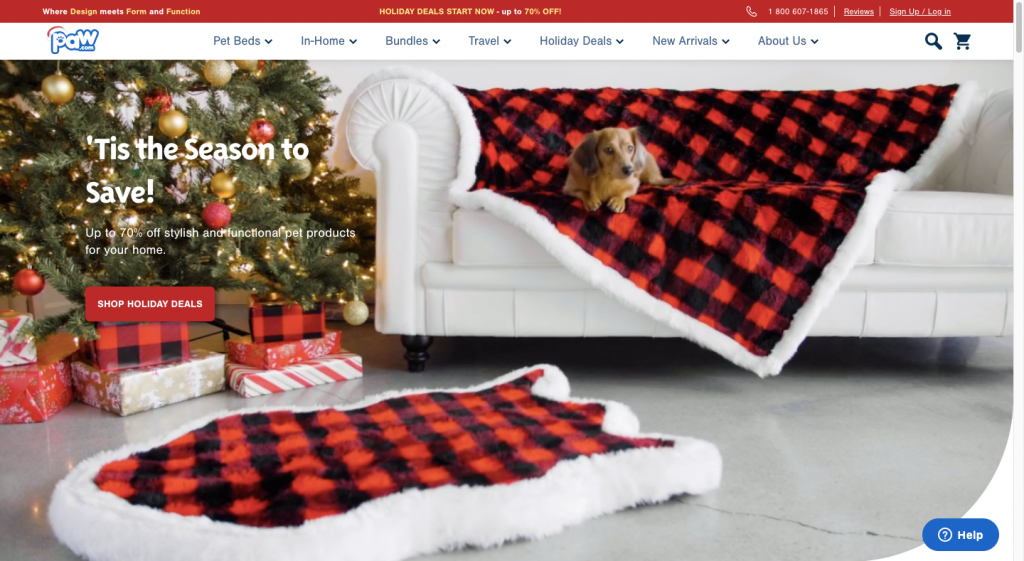
Just a few weeks ago, though, this is what the homepage looked like:
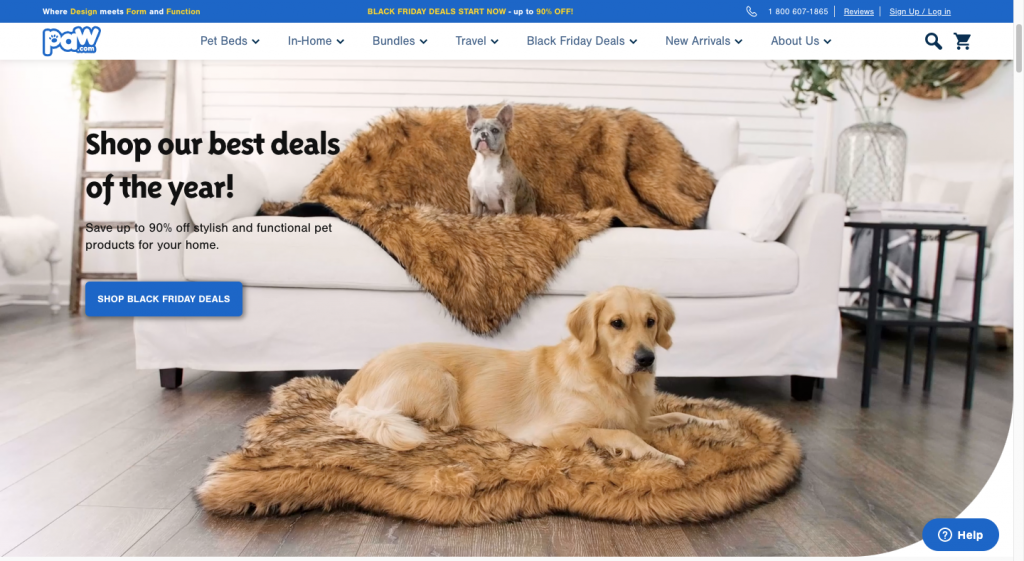
This is just one tool in the company’s marketing arsenal, but they’re taking full advantage of it. They’ve updated their sale notification bar, the navigation top-level links, the background hero video as well as the messaging.
Simply by keeping their brand up to date with shoppers’ habits and sentiments, brands should be able to close more sales over the course of the holiday shopping season.
What Makes a Great Holiday Marketing Strategy?
While consumers are certainly hunting around for “Black Friday” and other holiday season deals, that’s not necessarily enough to get them to stop what they’re doing and start shopping. Consider the following when you build out your holiday marketing strategy:
Audit Past Campaigns
If you’ve done holiday marketing in the past, this should be the very first thing you look at before formulating this season’s strategy.
Audit what happened in previous campaigns to find out:
- What worked and what didn’t in terms of offers
- Which days and schedules were most profitable
- Whether your audience looks the same this year as it did that year
- What errors were made and the lessons you learned from them
Once you have an idea of what you should be aiming for this holiday season, you can put together a set of SMART goals and KPIs to develop your strategy around.
Conduct Market Research
Every market is different when it comes to holiday shopping. For instance, if you look at data from Statista, these were the most searched for product categories for Black Friday in 2019:
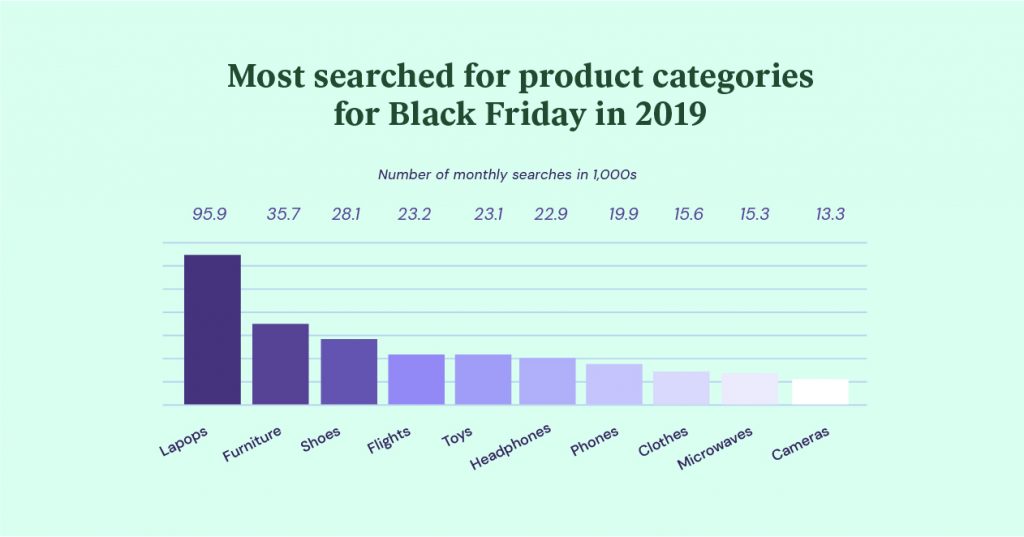
Let’s say you run an appliance store. Based on this data, you should probably put your microwaves front and center on your website, in your holiday ads, and even in the front showroom if you have a brick-and-mortar location.
But don’t just stop at generic holiday shopping research. Go deep into what’s happening within your industry to see what people want this season. Then check out what the competition is doing and has done in past years that worked well.
This will help you create the most competitive and attractive marketing campaign within your space.
Segment Your Audience
At this point, you likely have a clear picture of who your users are — what pains them, why they’re looking for brands like yours, what will motivate them to make a purchase, and so on. But when it comes to the holidays, in particular, you’ll need to do further user research and segmentation in order to optimize your strategy.
Here are some ways to segment your audience and create targeted campaigns for them:
New vs. Existing
Many times, the behaviors of new and existing customers will differ. For instance, according to Think with Google, customers may use technology somewhat differently when shopping:
“64% of existing customers, on average, engaged with a digital touchpoint during their shopping journey, while 80% of new customers, on average, engaged with a digital touchpoint during their shopping journey.”
With this info, you might decide to spend more on in-store and traditional media advertising to get in front of your existing customers.
Passive vs. Active
There are different types of existing customers. The ones who are active tend to be more loyal and will be attracted to different offers than those who haven’t bought from your brand or engaged with it in months.
If this is relevant to your brand, you may decide to push out exclusive holiday offers to loyal customers over more private channels, like push notifications or email. For other customers, your website and social media might be the better option.
Marketing Channels
As ecommerce grows in popularity with each passing holiday season, it’s important to consider the new technology trends that are fueling it.
For instance, a 2021 holiday shopping report from McKinsey reveals that Gen Z shoppers are using more mobile-specific channels:
“Eighty-seven percent of Gen Z say they expect to be inspired by social media, with YouTube, Instagram, and TikTok being their most likely sources of inspiration.”
So, if you’re targeting younger shoppers, it would make much more sense to run your marketing campaigns on channels and targeted to devices where they’re looking for it.
Check Your Resources
The high consumer demand over the holiday season means your brand needs to be prepared to answer the call in terms of:
- User experience
- Product availability
- Order fulfillment
- Customer support
It’s not always feasible to scale up your human resources over the holidays, even if it means more sales. But that’s okay. Your technology can help.
The first thing to do is get your website ready for the holiday season. Then, make sure your ordering and fulfillment systems are performing flawlessly.
You can even automate many of the tasks associated with holiday marketing — like scheduling your campaigns ahead of time, following up with customers who leave items in their shopping carts, and enabling your chatbot to engage with them in real-time for immediate support.
18 Great Digital Holiday Marketing Campaign Ideas
There are many avenues to go down with holiday marketing. Once you’ve sorted out what’s going to work best for your brand and audience, it’s time to implement your strategy.
While you can run your campaigns in non-digital formats, the following list solely focuses on using digital channels to promote your holiday:
1. Advertise Gifts in Your Website Navigation
Navigation is one of the most important elements on a website. For most of the year, it will probably be laid out the same way. However, around the holidays, you might want to give it a slight revamp.
Take the Aveda website navigation, for instance:
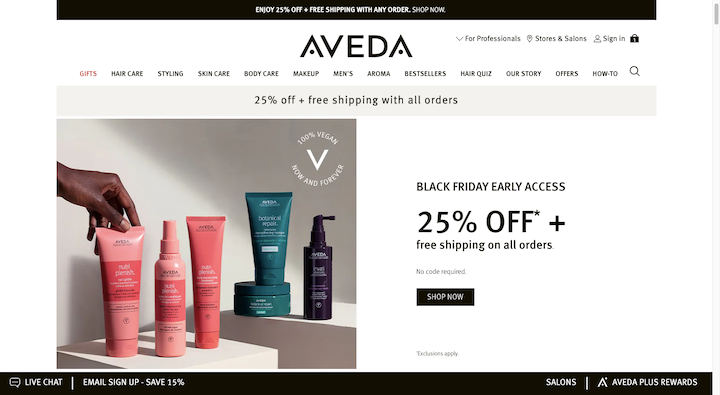
A “GIFTS” menu has been added to the front of the navigation bar. It’s a small change, but it’s one that visitors are going to notice right away, thanks to its primary position in the navigation as well as the red font.
It’s also a good idea to update your navigation if your holiday content is only promoted within your content — like in the prices on product pages. By updating your navigation with a new “Gifts” or “Sales” menu, visitors won’t have to jump back to the home page every time they want to look at your deals or recommendations.
2. Add a Holiday-Related Hero Image
The home page hero image sets the tone for the rest of the site. So once you figure out how festive you want your site to be and what type of holiday campaign you’re going to run, come up with a hero image that reflects it.
Ford, for instance, has gone all-in on seasonal imagery:
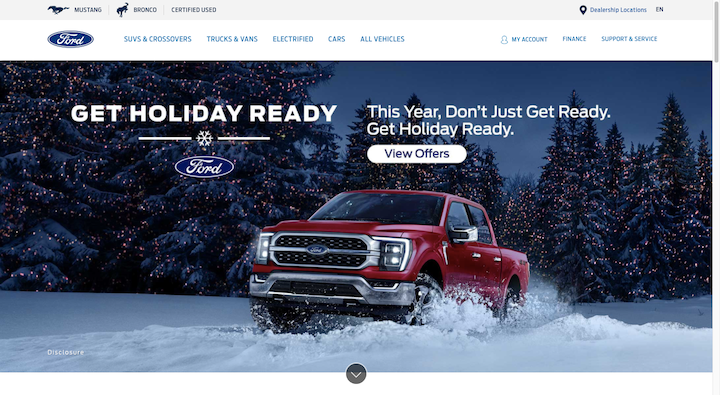
The hero image calls on shoppers to “Get Holiday Ready” and pairs the messaging with a truck driving through snow, against a backdrop of a forest filled with lights.
Your hero image doesn’t have to be this over the top in order to make an impact. GNC, for instance, has come up with this design:
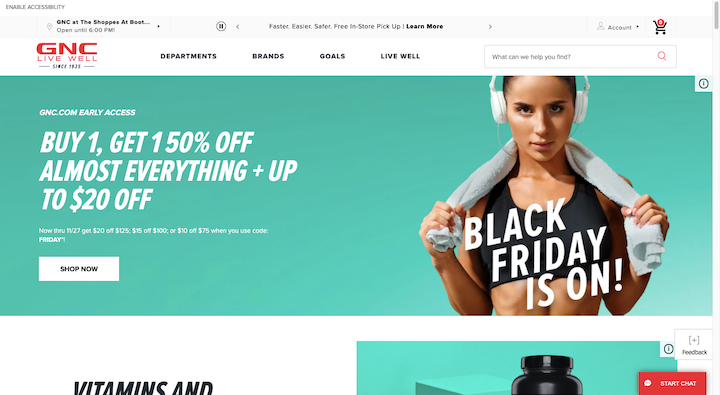
Since Black Friday is a sales day and not a holiday, GNC really doesn’t need to use festive or seasonal imagery to announce its sale.
That said, the hero image is still designed for maximum impact, with big, italicized copy and an eye-catching image.
3. Personalize Your Website with Holiday Content Blocks
Your hero image isn’t the only spot on the homepage where you can place holiday-related content. On The Ridges Resort home page, for example, there are two promotional blocks that appear below the fold:
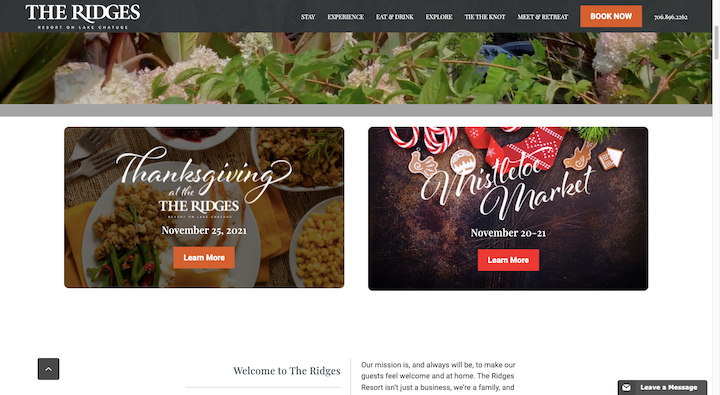
One is for Thanksgiving at The Ridges. The other is for the Mistletoe Market. Why are they here and not above the fold? Probably because they come second to advertising the resort and its normal hospitality services.
Ecommerce companies, on the other hand, may want to do a bit more with holiday marketing on the home page as Uncommon Goods does:
With the exception of the footer, the entire page is devoted to the holidays and gift-giving.
What’s nice about this design is that it’s not an endless barrage of products. Instead, Uncommon Goods does a great job organizing its gift guides into different categories for easier shopping.
4. Advertise Deals With a Countdown Timer in the Notification Bar
There always seems to be a sense of urgency associated with the holidays. So, the last thing you want to do is add to the stress and pressure associated with this time of year.
Countdown timers are a tricky element in web design. On the one hand, they resemble a ticking clock, which may be stressful for some. On the other hand, they can also be a helpful tool for shoppers.
By placing one in your notification bar, you can quickly remind shoppers how much time they have left to take advantage of your holiday sale.
Boll & Branch has one that advertises Black Friday early access:
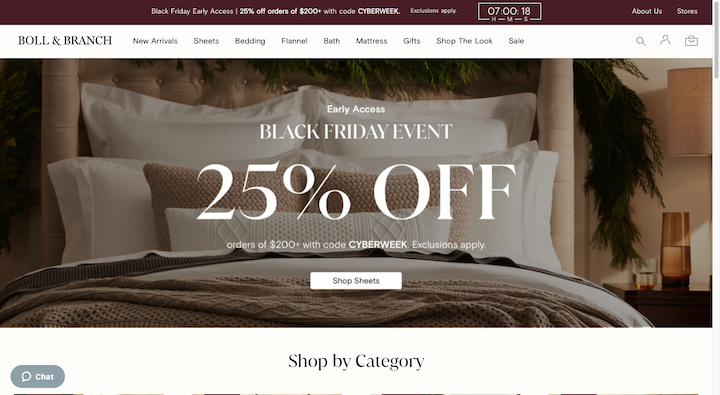
The design of the bar is subtle and blends well with the branding. Even the timer’s ticking seconds feel pretty tame.
You can always design your notification bar and timer to make a bigger impression. That’s what Reliefband has done:
The big red “Black Friday” striped notification bar not only has a more noticeable countdown but the “Shop Now” button wiggles around, begging shoppers to click on it.
5. Invite Website Visitors To Subscribe for Early Access to Deals
Black Friday, Cyber Monday, and other holiday sales events aren’t always relegated to one-off days. Some companies, for instance, run Black Friday marketing campaigns all week in the lead-up to Thanksgiving.
While there’s nothing wrong with going that route, some brands might not want to turn their site into a bargain bonanza for a week or more. Especially luxury brands.
If you sell higher-end products or services, that doesn’t mean you can’t still entice holiday shoppers with awesome deals. You’ll just need to run a more exclusive and controlled holiday marketing campaign.
The Pearl Source does this:
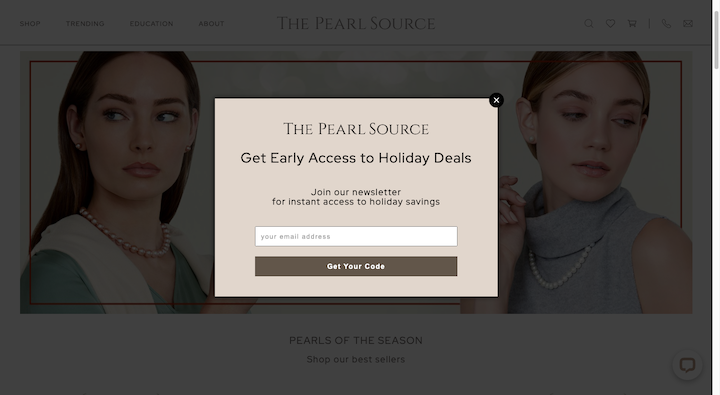
Visitors see this pop-up, inviting them to “get early access to holiday deals” when they join the newsletter.
Vincero Collective is another site that trades access to sales in exchange for the shopper’s email address:
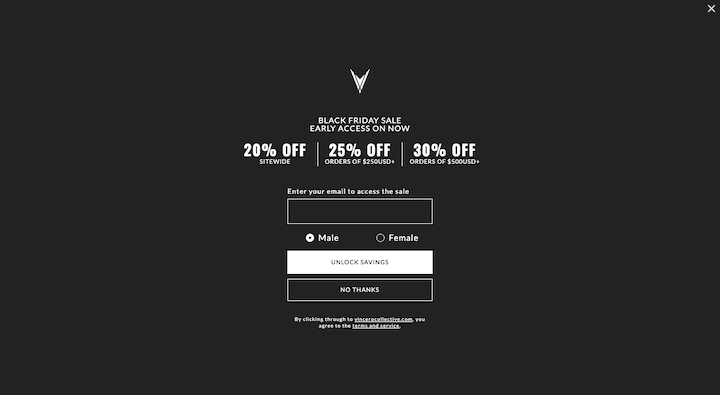
Unlike The Pearl Collective, though, Vincero tells customers beforehand what kinds of deals they’ll get in return for subscribing which might make them more likely to do so.
6. Publish Holiday Blog Posts
Blogging might not actively increase your sales, but it indirectly will if you create high-quality holiday content that your visitors can use.
For instance, Zoetis Petcare’s blog mostly publishes content related to taking care of pets. Around the holidays, though, blog posts like these will appear:
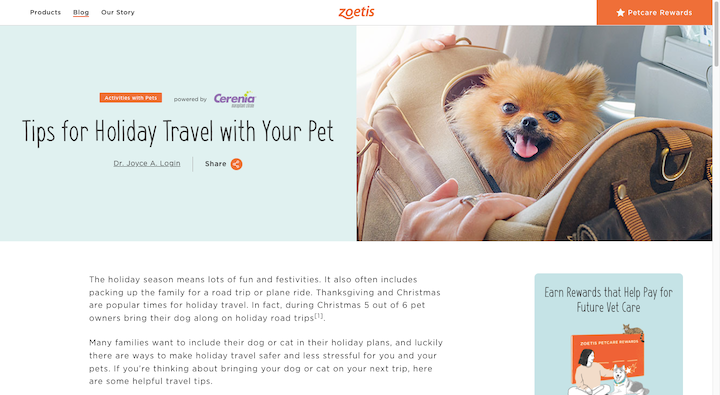
One reason to publish content like this is that it adds value to the shopping experience. For instance, customers worried about their pet developing nausea while traveling can refer to this resource and then see if the promoted product is right for them.
Another reason to publish content like this is that these are the kinds of questions people ask online. Write a good enough post and Google might just rank it on the first page of search results — giving even a new company more visibility around the holidays.
If you create enough holiday-centric content for your blog, you can dedicate entire navigation categories or sections of the home page to it. That’s what The Pioneer Woman does:
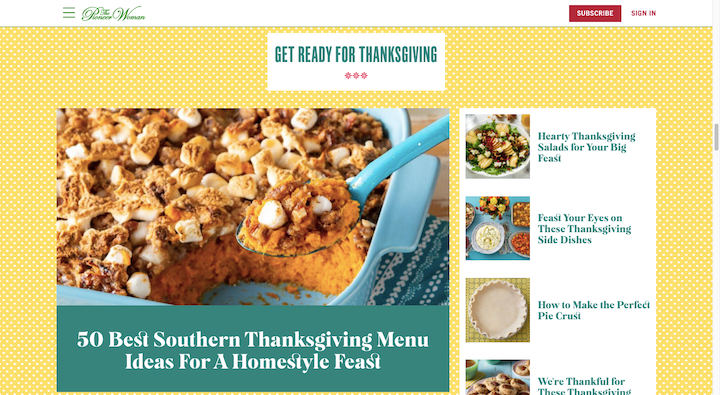
This screenshot is from the home page, taken about a week before Thanksgiving. But it’s not just during the holiday season when visitors have access to this content. The navigation has a permanent category for “Holidays” and sub-categories for “Gifts”, “Thanksgiving” and “Christmas”.
7. Direct Traffic to a Custom Landing Page from Google
Data from Google reveals that holiday shopping-related search terms like “holiday gift ideas” and “local gift shops near me” have skyrocketed in recent years. What’s more, consumers are doing these types of searches much earlier in the year.
While it’s important to prepare your store for the holidays and to create content for your blog, email, and social media to attract shoppers, don’t forget where the user’s journey often starts: Google.
There are a number of ways to put Google to work for you. Take this search for “gift ideas for boyfriend 2021”:
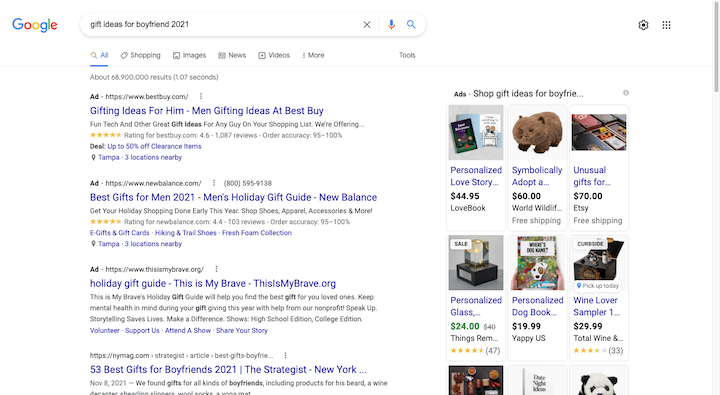
The first three results are pay-per-click ads from Best Buy, New Balance and This Is My Brave. We also see a slew of paid product placements along the right side of the search results.
If you create a Google ad, make sure you create a custom landing page for it, too. That’s what Best Buy has done here:
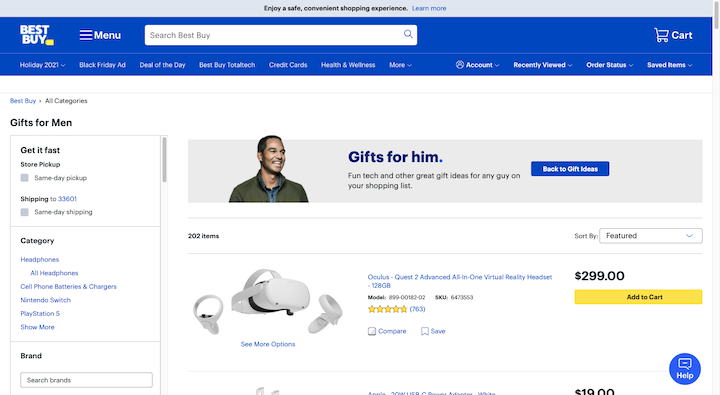
Rather than redirect Google users to the Best Buy home page or a generic “Gifts” category page, this page is an aggregation of gifts chosen specifically for the man in your life.
Pay-per-click isn’t the only way to attract holiday shoppers to your site. Good old search engine optimization helps, too. Just remember this is about more than keyword matching. You have to write high-quality content that offers helpful holiday shopping recommendations if you want it to rank.
8. Create Helpful Holiday Video Content on YouTube
On average, 39% of U.S. holiday shoppers use YouTube videos for holiday shopping inspiration according to Statista. Here’s the breakdown by age group:
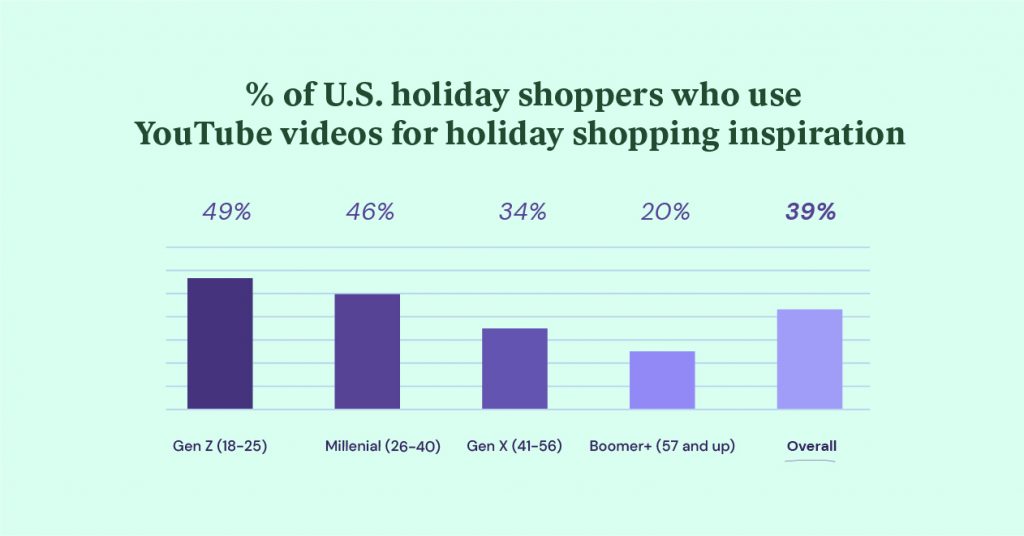
Nearly half of Gen Z and Millennial shoppers get their inspiration from YouTube. Considering how great their spending power is, that makes YouTube a holiday marketing channel worth pursuing.
There are a couple of ways to do this.
You could run display or interstitial ads on YouTube. However, if users are looking for inspiration, it would be more beneficial to create content that helps them prepare for the holidays, find gift ideas, and get a first-hand look at what they’re thinking about spending money on.
Consider this video from Laura in the Kitchen’s YouTube channel:
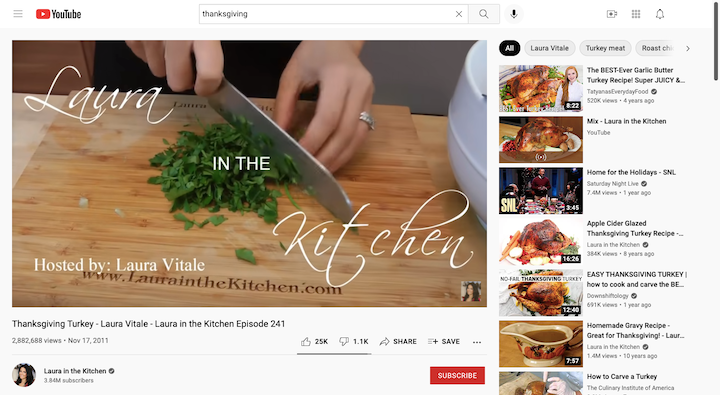
Laura walks viewers through the process of preparing a Thanksgiving turkey. To date, the video has received over 2.8 million views and 25,000 likes. This kind of content has been great for boosting Laura’s brand awareness.
Also, notice what she’s put in the description:
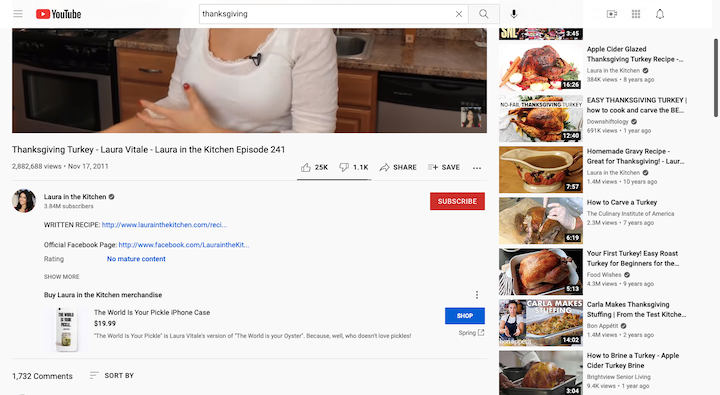
She’s included a link to the written recipe on her site, which may encourage viewers to explore her other recipes, click on affiliate links or buy something from her shop. There’s also a link to her Facebook page, which will enable her to grow her audience further. And she’s also included a promo for Laura in the Kitchen merchandise.
This is a good example of how, even when a YouTube video itself isn’t monetized, the content and supporting information can help a brand grow its sales over the holidays.
9. Create an Unforgettable Sales Event
Cards Against Humanity launched a unique holiday marketing campaign for Black Friday 2018. They even launched a separate website to promote the 99% Off Sale:
The online store had dozens of items on it — all available at 99% off the regular ticket price — from outlandish products like a coffin to stuff that people really wanted to buy like a Ford Fiesta which sold for only $97.
With limited quantities of each item available, the store’s inventory quickly depleted over the course of the day, which kept shoppers continually engaged with it. In terms of a holiday marketing scheme, it was a success. In terms of achieving the campaign’s goals, however, it was a major flop. According to Cards Against Humanity:
“The only item that didn’t sell out was our brand-new Absurd Box. This was by design: our plan was to capture people’s attention with the promotion and direct it toward our new product. Unfortunately, people were too distracted by the outlandish deals to notice the Absurd Box and the promotion was a financial catastrophe.”
That said, the concept of running a totally unforgettable sales event cannot be discounted, so long as you don’t spend excessively to make it happen. This campaign generated a ton of press for the brand and likely brought new users into the fold that never would’ve otherwise known about it.
10. Run Holiday Ads on Other Sites
One of the reasons why you need to know who your target users are and to segment them is so you can run effective pay-per-click holiday campaigns. This goes for Google just as much as it does the ads you run on other sites.
For instance, this is a “Christmas in California” blog post on the A Passion and a Passport site:
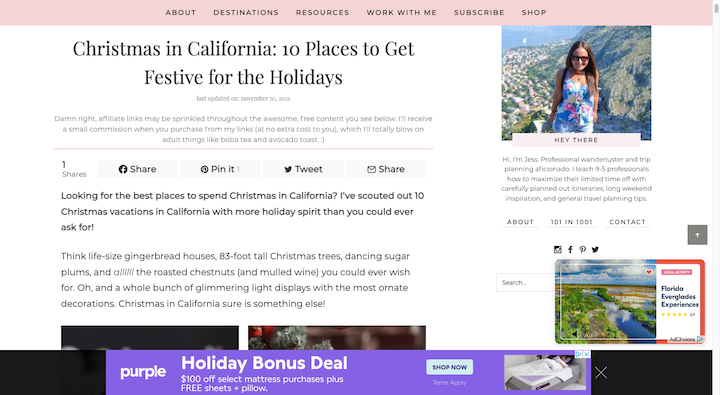
At the bottom of the site is a sticky ad for Purple. The mattress company used this opportunity to retarget a recent visitor (that being me) with a “Holiday Bonus Deal”. With its on-brand purple and mattress imagery, I instantly recognized what it was for and took notice of the offer.
Another way to expand your brand exposure during the holidays is to run sponsored posts on other sites. That’s what we see here with Eater:
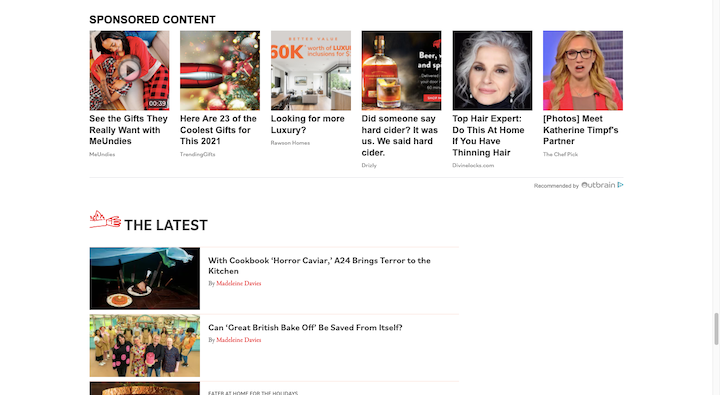
Beneath each post is a Sponsored Content section. This one actually has a number of holiday-specific posts — ones from MeUndies, TrendingGifts, and Drizly.
11. Get the Local News To Cover Your Holiday Event or Offering
We’ve already seen one way to get the news talking about your holiday sale (i.e. Cards Against Humanity). But you don’t have to do something outlandish to get the news to report on it.
Local newspapers and sites do holiday roundups every year. This is their way of generating more interest around the holidays from current, past, and new readers.
If you run a local business, why not leverage these resources to spread the word about what you’re doing? Take this article on Kansas City’s FOX 4 site about holiday-themed pop-up bars:
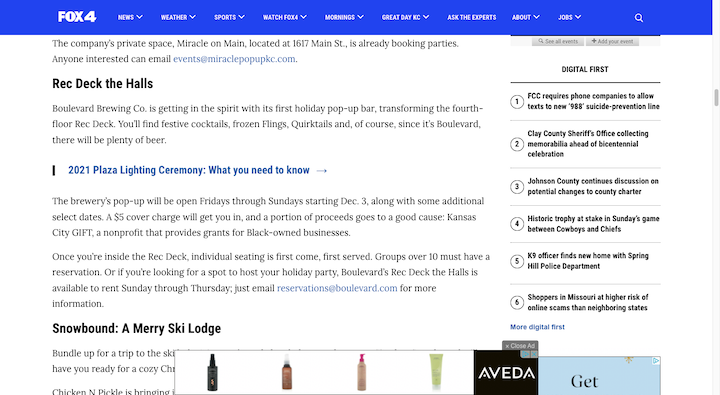
The roundup mentions a number of Kansas City bars hosting holiday events. Boulevard Brewing Company is one of the bars and its website is prepared to handle the incoming traffic from interested FOX 4 readers:
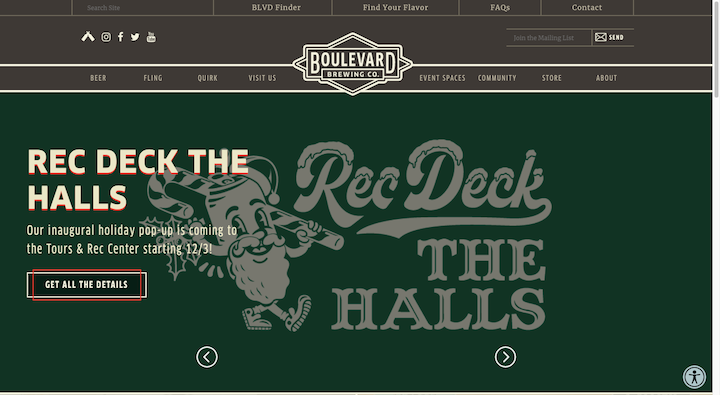
Visitors won’t need to look up “Events” or scroll through the home page to find more information on the pop-up. Boulevard Brewing is promoting it right there in the hero image.
12. Host a Live Shopping Event on Social Media
If you like what Cards Against Humanity did, but don’t want to take it to that extreme, consider hosting a live shopping event on social media instead.
Sephora, for instance, announced its Cyber Week live shopping event on Facebook in mid November:
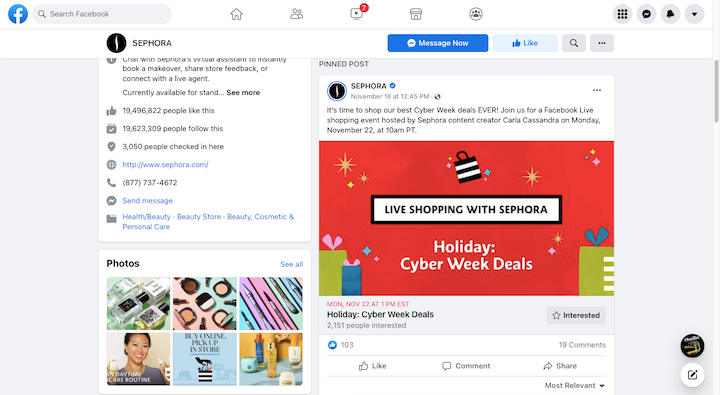
As of writing this (just a few days after it was posted), the event has 2,151 people interested in attending.
For companies that sell goods that shoppers typically want to feel or try on before buying, this kind of holiday marketing campaign could be great for you. Not only do shoppers get to see your reps use the products in real time, but they’ll get a chance to engage with them, ask questions, and so on.
13. Promote Your Upcoming Holiday Sale on Social Media
If your holiday sale events are relegated to your website, don’t stress. You can also use organic (free) social media marketing to promote your upcoming deals.
That’s what Pepper Palace is doing on platforms like Twitter:
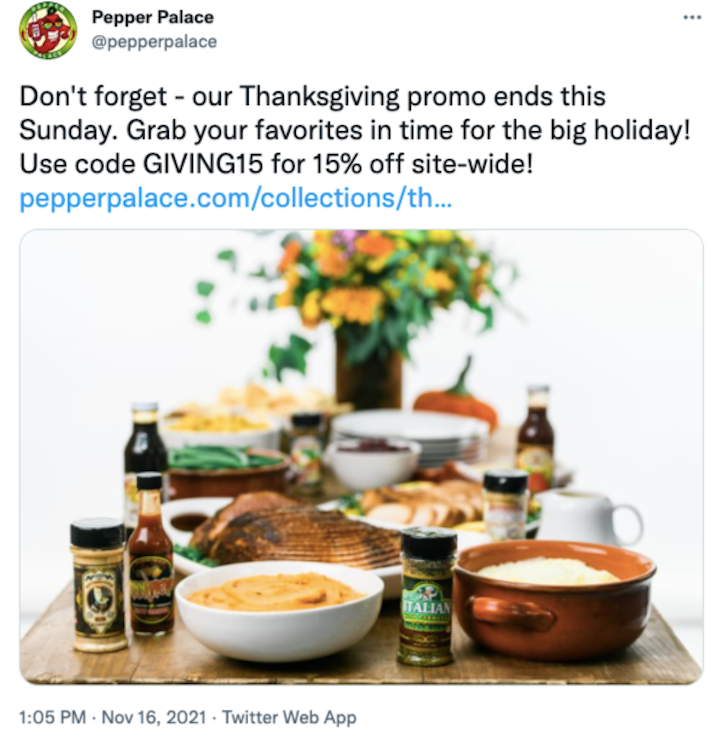
Even if people initially fail to notice the message and 15% off code in the post, the picture should get them to stop.
The accompanying image is of a not-so-typical Thanksgiving spread. Instead of framing the turkey as the central component of the feast, there are a variety of seasonings and hot sauces spread out around the table.
14. Run Social Media Ads To Promote Your Sale
Social media ads are an effective way to generate brand awareness and grow sales over the holidays. According to data on Statista:
“During a June 2021 survey fielded in the United States, 35 percent of respondents stated that their purchasing decisions were influenced by social media ads; among respondents born between 1998 and 2006 (Generation Z), the share stood at 75 percent.”
Just keep in mind that market research and target user segmentation is a must if you plan on running ads. You want to make sure you get the biggest bang for your buck.
Kiehl’s is a brand that’s clearly done its homework. This ad appeared in my Instagram feed a week after I’d done some research on its skincare products:
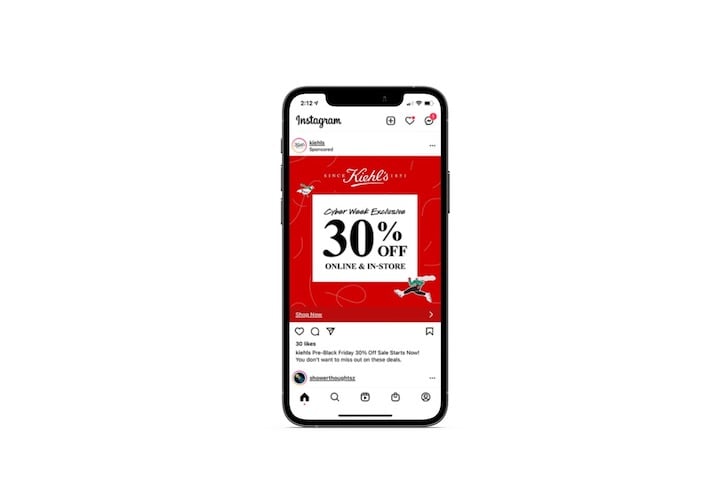
With the bright red background and the big 30% off, it was impossible to miss this ad.
One of the benefits of advertising on a platform like Instagram is that you can run animated or video ads and they’ll autoplay as visitors scroll through their feed. Here’s an example from Sea World Orlando:
Since users don’t have to directly engage with the ad to make it move (the way they might on a platform like Twitter), it’s much easier to capture their attention through motion ads here.
15. Share Links to Holiday Tips, Tricks and Gift Guides on Social Media
It’s not a bad idea to bring attention to your products, holiday shopping guides, or recommendations on social media either.
According to a Deloitte holiday retail survey, 28% of people use social media to help them with their holiday shopping. 56% of those consumers said they use it specifically for research purposes.
So while social media can be an effective way to advertise your holiday sales, don’t forget about the earlier part of your users’ journey when they’re in the discovery and research phases.
Chewy’s Pinterest posts are a good example of how to reach this segment of users:
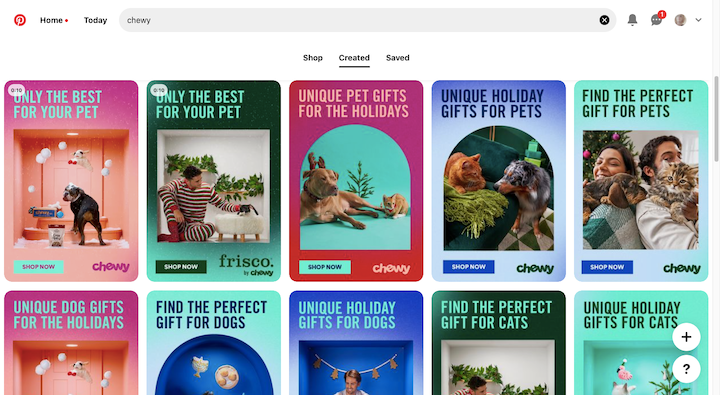
You don’t see anything here about BOGO sales or anything like that. They’re just beautifully designed pinned content that provides pet owners with gifting ideas for the holidays.
16. Send Emails That Make the Holidays Easier for Customers
The holidays can be a stressful time for people. While it’s awesome when you can offer them a great deal on something they’ve been wanting or needing, that’s not the only thing that’ll get them to notice and grow to trust you.
Email is actually a great platform for providing subscribers and customers with some much-needed relief over the holidays. Take this email that The Fresh Market sent to customers on November 12:
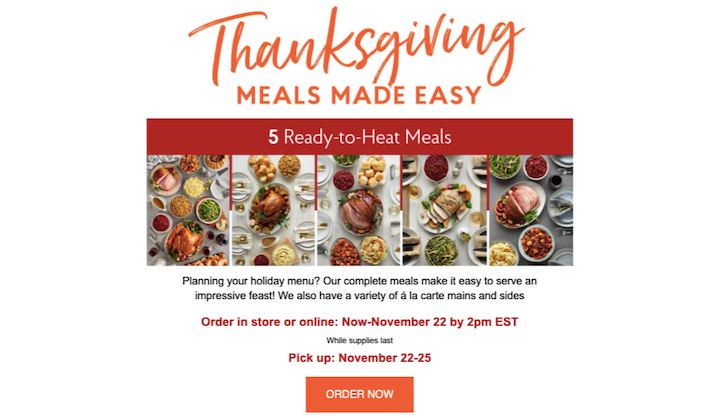
Most customers knew — or at least expected — that they’d be able to buy a turkey and all their Thanksgiving fixings from The Fresh Market. However, this message lets them know that they have another option available.
Considering how long it can take to prepare a Thanksgiving dinner even for a small family, this email went out at just the right time and with the perfect solution: Ready-to-Heat Meals that can be ordered ahead and picked up.
Even if you don’t have an alternative solution to offer to your customers, consider how a well-timed and helpful message or tip might help them out over the holidays. When it comes time to open their wallets, that might be all the motivation they need to go to you first.
17. Lure Old Customers Back via Email With an Exclusive Offer
It’s not always easy to reconnect with former customers and to get their business back.
For starters, unless you’ve stayed in touch with them, you can’t possibly know if their circumstances have changed that made them leave in the first place. Secondly, you don’t want to make an offer that’s so far below what they paid before that they wonder if you ripped them off the first time around.
But a holiday sale is different. Consumers expect businesses to make deep cuts to their prices. A recent Finder survey found the following:
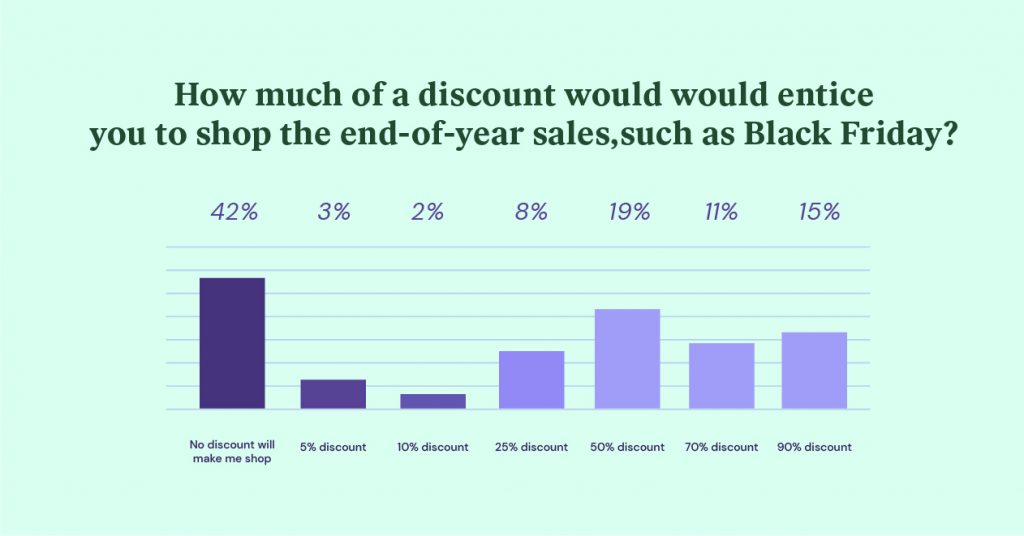
Respondents were asked how big of a discount would entice them to shop the end-of-year sales:
- 19% wanted 50% off
- 11% wanted 70% off
- 15% wanted 90% off
For those that take advantage of holiday sales, it’s clear that the deeper the discount, the better.
That’s why an email like this one from Mangools makes a lot of sense:
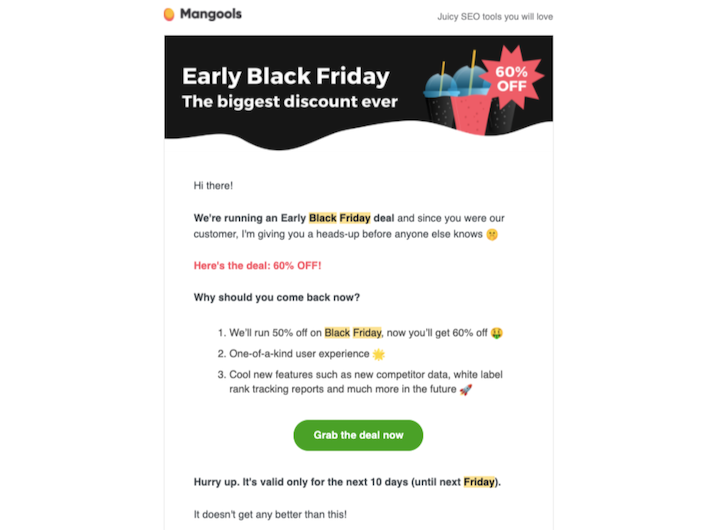
While first-time Mangools customers get access to a 50% discount when they shop on Black Friday, former customers are getting a 60% early access discount.
18. Show Your Gratitude to Customers Over Email
Not every business can afford to run a holiday sale. That doesn’t mean they get to miss out on spreading holiday cheer and using holiday marketing content to connect with their audiences.
East Bay Inn, for instance, isn’t advertising any holiday sales or events on its website or social media. However, it did send this message to former guests recently:
There’s nothing self-promotional in the email. It’s a simple message of thanks and well wishes, which makes the Inn feel a lot more like a relative sending a “thinking of you” holiday card than a business begging a customer to come back.
Even if you do have something to promote this holiday season, consider using email marketing to spread the kind of care and joy you want your brand to be synonymous with all year long.
Conclusion
There’s a lot of noise online throughout the months of November and December. It seems like every brand is getting into the holiday marketing spirit.
So, how do you cut through the noise and capture the attention of shoppers?
The key is to get in front of them at the right place, at the right time, and with the right messaging. As you can see above, there are many ways to do this — on your website, other people’s websites, search engine results pages, social media feeds, and email inboxes.
Looking for fresh content?
By entering your email, you agree to receive Elementor emails, including marketing emails,
and agree to our Terms & Conditions and Privacy Policy.
